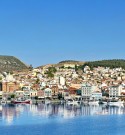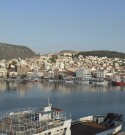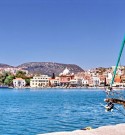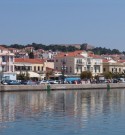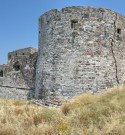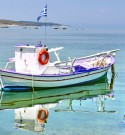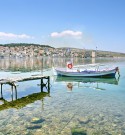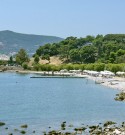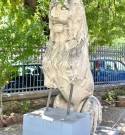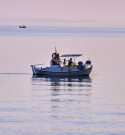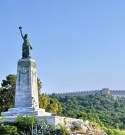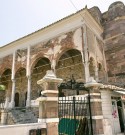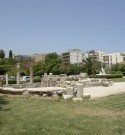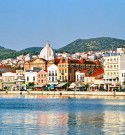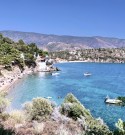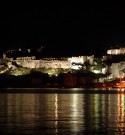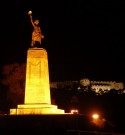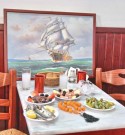Mytilene is the capital of Lesvos. The town of Mytilini was first founded on the small island where the enetic castle was later constructed.
Herodotus dates the foundation of the town, in his work ” Homer’s Life”, 130 years after the conquest of Troy, that is to say around 1053 a. C., if the conquest of Troy took place in 1183, as historians say. Mytilene reached her highest development around the 7th-6th century with the philosopher Pittakos and the poets Alkeos and Sapho. Mytilene got her name by one of Makaras’ daughters, the island’ s first colonist.
The Area of Mytilene consists of the villages Agia Marina, Taxiarches, Loutra, Panagiouda, Moria, Alyfanta, Afalonas, Pamphila and the city of Mytilene. It is about 188 miles from piraeus and it has about 25000 inhabitants.
Impressive buildings of a neo-classic architecture, historical monuments, unique archaeological treasures, like the mosaic-works found at Menandros’ s House (exhibited now at the Archaeological Museum) and the natural hot springs compose a rich cultural context. In the centre of Mytilene we will find the Ministry of North aegean, the Regional Administration of the North Aegean and the Central Administration of the University of the Aegean.
The construction operations of the waste treatment system, not only contribute to the improvement of the quality of the citizens’ life but they also contribute to the discovery of archaeological treasures found in the centre of Mytilini during the operations.
These archaeological treasures are exhibited either at modern museums or at specially equipped open – air spaces that are impressive and have a unique historical value.The town’ s foundations are extended over seven adjoining hills.
The centre of the town is divided into three main parts: Kioski, which is a very beautiful suburb, the central old neighbourhoods and the west neighbourhoods. The efforts of the authorities to reconstruct the centre of the town and to adapt the needs of the Municipality of Mytilene to the demands of the new century are remarkable. Kioski, the old aristocratic suburb of Mytilini where we can find the new Archaeological Museum, is not far away from the Enetic Castle.
The Castle was situated on the isolated, by the channel of Euripus, part of Mytilini and seemed like a small island. The channel of Euripus, along which there were a lot of bridges, had been uniting, in the past, the south port to the north port dividing, this way, Mytilini in two parts. At Kioski there are still authentic mansions of a traditional Lesbian architecture.
The main street that goes through Kioski leads to the north port, where we can see the shattered quay and other ruins of the past. In a small distance from there, there were found ancient ruins and the entrance of the channel that was mentioned above.
Important ruins of ancient and roman structures are also discovered in the north part of Mytilini.
Along the coast that starts from the Custom House (Teloneio), the visitor has the possibility to enjoy an interesting stroll, during which he will have the chance to admire the mansion, where the old Archaeological Museum is established, the beach that belongs to the Greek Touristic Organism (EOT), the small and clean beach, called ” t’ apeili”, and above that, on a small hill among the pine trees, the bust of Sapho, the poetess, worked out artistically and given to the Municipality of Mytilini by the American artist Erietta Fors.
Neapolis site is at a distance of a few Kilometers away from Mytilene’s town – the capital of Lesvos island – . It’s a piney area beside the sea, with many country-houses, and shops for refreshment and entertainment.
The basic element that dominates to the area is relaxed rhythms of life. Although the area is not far away from Mytilene, its architectural style divides it from the capital and so it is characterized as Mytilene’ s suburb. Luxurious hotels, cafes, bars, restaurants and taverns are expecting you all around the year. Neapolis is the main road junction between Mytilene and the surrounding villages.
Not far away from there, we find Varea site, another suburb with a unique cultural history, with the museums of the famous Lesbian painters : Theophilos Chatzimichael -folk painter -, of modern art and the library of the art-critic Stratis Eleftheriadis – Terriade, including precious works of art ( Picasso, Shagal, Mattes, Tsarouchis and other’s ).
As we go upwards we can visit the villages of Taxiarchis, Ayia Marina and Pligoni. Each one is unique. For instance, Taxiarchis village is situated on the eastern slopes of Mt Amali, having fantastic view of the Aegean Sea.
It is surrounded by a huge rock on the top of which Taxiarchis ( Archangel Gabriel ) church is built. It is a Byzantine church built during the years 1903-1958 and has replaced an older and smaller one. A rare fresco of Taxiarchis has been rescued ( painted in the 17th century ), which today is being exhibited inside an iconostasis.
At the village’s market we can see an old fountain constructed in 1753 and renovated in 1875. Also worth seeing are the underground springs at the small church of Ayia Thekla with arches constructed by tiles. There we find the post-Byzantine church of Panayia Potamoussa and the cave of Ayios Vartholomeos ( at Loutra site ).
Afterwards the road guides us to the village of Ayia Marina with old and picturesque little stone-paved streets. There we can visit the three-isled Byzantine church of Ayia Marina -built in 1797 – and that has been characterized as an archaeological area. It owns a wonderful wood-sculptured temple and a throne, both of them created in 1839. The ruins of an older Byzantine church (Panayia Amalis) have been used for the church’s construction. Here we find the mansion of Vernardakides ( rich Lesbian family ) and a monumental public fountain ( 1818 ). At the area of Neapolis’ beach a Byzantine basilica has been excavated including a baptistirium and precious mosaics of its central isle. It is a construction of the 5th century. At the upward area of the airport we find the springs of river Loudias that had been supplying with water Mytilene during ancient times. There we can see ten water-mills that were functioning till the year 1941. Pligoni is another village of the area, situated at a green site
After Neapolis we meet Kratigos area : the airport, fantastic beaches, pubs and various accommodations. We have to notice that during the construction of the airport ruins of ancient ( Hellenistic ) temples and Byzantine churches were brought to light. It’s very possible that here the ancient temple of god Apollo had been built as the Greek historian Thouckidides describes in his historic manuscripts.
At a distance of 16Km away from Neapolis – after the gorgeous beach of Charamida – we visit the piney area of Ayios Ermogenis with the homonymous small church built on a rock just beside the sea. Crystal like water and fish taverns just beside the sea waves are expecting you for fresh fishes and the local drink ouzo.

